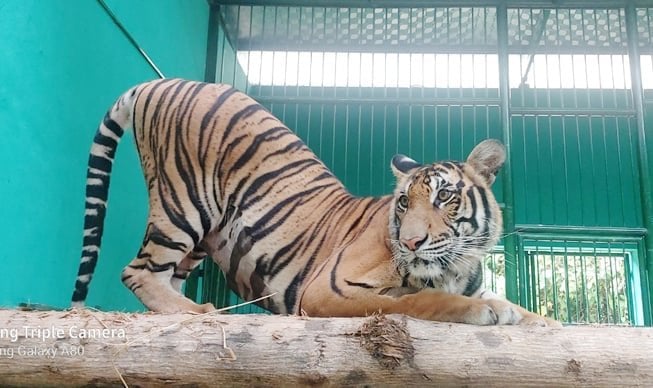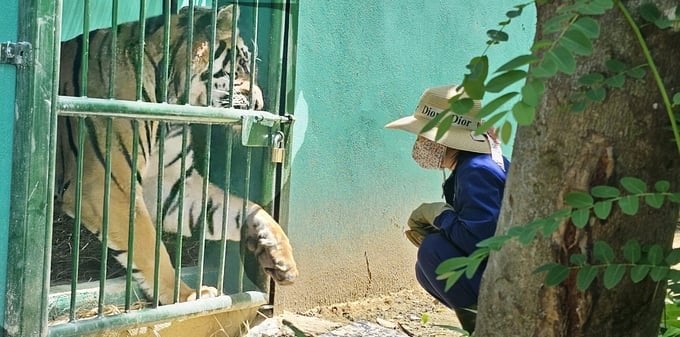May 20, 2025 | 22:24 GMT +7
May 20, 2025 | 22:24 GMT +7
Hotline: 0913.378.918
May 20, 2025 | 22:24 GMT +7
Hotline: 0913.378.918

Every day, Indochinese tigers need about VND 500,000 of food. Photo: Tung Dinh.
Indochinese tigers have been endangered on the IUCN Red List since 2008, when their numbers seriously declined and approached the critically endangered threshold. The conservation of this species receives special attention from many countries in Asia.
At Phong Nha-Ke Bang National Park, tiger conservation efforts began around 1993. Mr. Dinh Huy Tri, Deputy Director of the Park, shared that information about tigers is often given top priority, aiming to achieve the goal of protecting tigers. The long-term goal is to preserve and stabilize the ecosystem.
For many years, Phong Nha-Ke Bang National Park has also focused on education, raising awareness, and coordinating hunting prevention programs, including a program to recover illegal guns from the community locality patrol program with people's participation.
Periodically, Phong Nha-Ke Bang National Park organizes research, monitoring, and investigation to record and detect the existence of new species and changes in tiger living space.
In 2022, Phong Nha-Ke Bang National Park cooperated with Pu Mat National Park to rescue and preserve seven Indochinese tiger individuals.
Regarding tiger conservation, there are many different views. Mr. Tri admitted that conserving species and preserving the ecosystem together is the best solution. However, this is only sometimes possible in practice. Specifically with the Indochinese tiger, he believes that conservation activities should have been implemented 30 years ago.
"Now we are forced to come up with a solution, perhaps finally, to retain precious genetic resources, especially in the context that the number of Indochinese tigers in the wild is low," Mr. Tri said.
Due to limited resources and implementation time, Mr. Tri believes the ex-situ conservation method is more suitable for Indochina tigers now.
"Any action needs to take into account a vision for the future. In the long term, if you want tigers to survive, you must let them survive, which means you need the genetic material of the living species. After that, the new program aims to reintegrate tigers into the wild," Mr. Tri continued.
Many countries implement this model worldwide; for example, Lebanon has reintegrated rhinos. In Quang Binh, the Lophura edwardsi was also tested using this method and showed positive results at Dong Chau-Khe Nuoc Trong Nature Reserve, Le Thuy district.

The lifespan of Indochinese tigers ranges from 15-20 years, depending on living conditions. Photo: Tung Dinh.
Phong Nha-Ke Bang National Park is also implementing other measures, such as coordinating with domestic and international organizations, including the Animals Asia Foundation, Soc Son Hanoi Wildlife Rescue Center, etc.
"We always integrate lake conservation into related programs and projects to achieve the common goal of preserving wildlife biodiversity," Deputy Director of Phong Nha-Ke Bang National Park emphasized.
Another problem mentioned by experts on Indochinese tigers is the problem of inbreeding. Because the number of Indochinese tigers is decreasing, conservation facilities for this species need help growing the number of individuals.
To solve the problem, Phong Nha-Ke Bang National Park believes that it is first necessary to decode and understand each Indochinese tiger's genetic map. If favorable, Phong Nha-Ke Bang National Park will breed to keep the gene source in place. On the contrary, they will let tigers cross-breed with individuals at other facilities.
Some facilities have been contacted by Phong Nha-Ke Bang National Park, such as the Hanoi Wildlife Rescue Center, which is raising more than 40 tigers. In addition, they have facilities in Thailand, Cambodia, and Laos. As long as there is a suitable individual, Phong Nha-Ke Bang National Park commits to immediately contacting them.
"With seven tigers currently here, it is probably almost impossible to release them into the wild because they breed in captivity, and their ability to forage in the wild has been eroded," he said. Tri raised the issue.
Therefore, leaders of Phong Nha-Ke Bang National Park place hope on the F1 generation of current tiger individuals. He said that experts on Indochinese tigers have prepared some scenarios to give the cubs the habits and ability to survive in the wild. The ultimate goal is to return them to nature.
At the same time, Phong Nha-Ke Bang National Park will review and evaluate in detail the entire area where tigers are planned to be reintroduced. In particular, we must consider strengthening safety solutions to protect tigers and humans in the surrounding area.
"It is a longer story, not one or two years, and needs to be shaped soon with a synchronized plan of relevant parties," Mr. Tri admitted.
Translated by Huong Giang

(VAN) Japan's grant aid project contributes to capacity building, promoting organic agricultural production, and fostering sustainable community development in Dong Thap province.

(VAN) For years, the CRISPR-Cas9 genome technology has been reshaping genetic engineering, a precision tool to transform everything from agriculture to medicine.

(VAN) Vietnam aims to become a 'leader' in the region in the capacity and managing effectively soil health and crop nutrition.
![Reducing emissions from rice fields: [Part 1] Farming clean rice together](https://t.ex-cdn.com/nongnghiepmoitruong.vn/608w/files/news/2025/05/05/z6509661417740_a647202949c539012a959e841c03e1d3-nongnghiep-143611.jpg)
(VAN) Growing clean rice helps reduce environmental pollution while increasing income, allowing farmers to feel secure in production and remain committed to their fields for the long term.
/2025/05/19/5136-1-144800_230.jpg)
(VAN) The Nghe An Provincial People's Committee has just approved the list of beneficiaries eligible for revenue from the Emission Reductions Payment Agreement (ERPA) in the North Central region for the year 2025.

(VAN) 14 out of 35 domesticated elephants in Dak Lak province have had their living conditions improved, with 11 of them currently participating in the non-riding elephant tourism model.

(VAN) Muong Nhe Nature Reserve hopes that being upgraded to a national park will lay the foundation for forest protection efforts to be carried out in a systematic, modern, and sustainable manner.